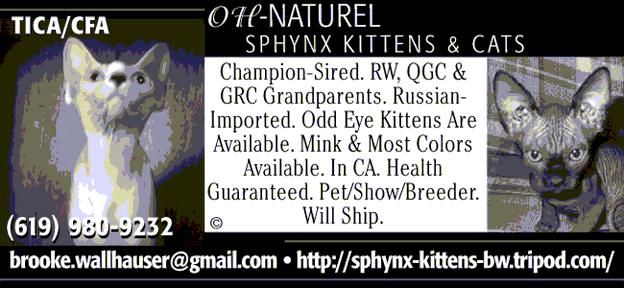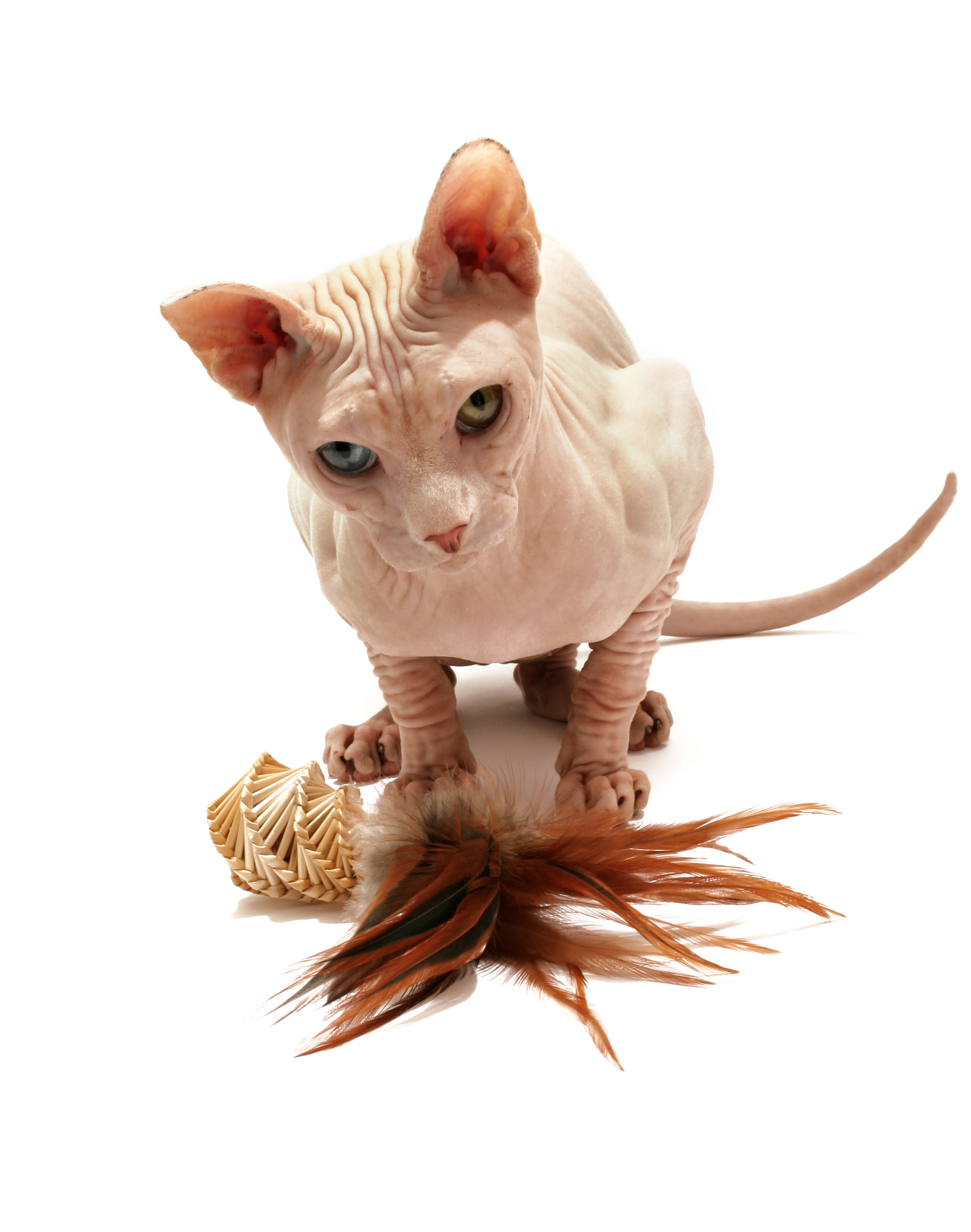|

|
|
| My cattery is given credit for have a sphynx on their cover page of the Oct 2010 issue of Cat Fancy |

CFA SPHYNX STANDARD
GENERAL: the most distinctive feature of this cat is its appearance of hairlessness. The Sphynx is of medium size and
body conformation with surprising weight for its size. Females are generally smaller than males. The head shape is a modified
wedge, with prominent cheekbones and whisker pads giving a squared appearance to the muzzle. The body feels warm and soft
to the touch, with a skin texture akin to either a soft peach or a smooth nectarine. The Sphynx is sweet-tempered, lively,
and amenable to handling.
HEAD: the head is slightly longer than it is wide, with prominent cheekbones and a distinctive whisker break. The skull
is slightly rounded with a flat plane in front of the ears. The nose is straight and there is a slight to moderate palpable
stop at the bridge of the nose.
CHEEKS AND CHEEKBONES: prominent, rounded cheekbones which define the eye and form a curve above the whisker break.
MUZZLE AND CHIN: whisker break with prominent whisker pads. Strong, well developed chin forming perpendicular line with
upper lip.
EARS: large to very large. Broad at the base, open and upright. When viewed from the front, the outer base of the ear
should begin at the level of the eye, neither low set nor on top of the head. The interior of the ears is naturally without
furnishing
EYES: large, lemon-shaped, with wide-open center while coming to a definite point on each side. Placement should be at
a slight upward angle, aligning with the outer base of the ear. Eyes to be wide set apart with the distance between the eyes
being a minimum of one eye width. Eye color immaterial.
BODY: the body is medium length, hard and muscular with broad rounded chest and full round abdomen. The rump is well rounded
and muscular. Back line rises just behind the shoulder blades to accommodate longer back legs when standing. Boning is medium.
NECK: the neck is medium in length, rounded, well muscled, with a slight arch. Allowance to be made for heavy musculature
in adult males.
LEGS AND FEET: legs are medium in proportion to the body. They are sturdy and well muscled with rear legs being slightly
longer than the front. Paws are oval with well-knuckled toes; five in front and four behind. The paw pads are thick, giving
the appearance of walking on cushions.
TAIL: slender, flexible, and long while maintaining proportion to body length. Whip-like, tapering to a fine point.
COAT/SKIN: the appearance of this cat is one of hairlessness. However, short, fine hair may be present on the feet, outer
edges of the ears, the tail, and the scrotum. The bridge of the nose should be normally coated. The remainder of the body
can range from completely hairless to a covering of soft peach-like fuzz, no longer than 1/8th of an inch (two millimeters)
in length. This coat/skin texture creates a feeling of resistance when stroking the cat. Wrinkled skin is desirable, particularly
around the muzzle, between the ears, and around the shoulders. There are usually no whiskers but if whiskers are present they
are short and sparse.
COLOR: color and pattern are difficult to distinguish and should not affect the judging of the cat. White lockets, buttons,
or belly spots are allowed
Apperance:
Once you get used to looking at a naked cat, you will notice that this breed has other distinctive traits. Their
ears, for one thing, look large enough to intercept satellite transmissions. Their paw pads are thick, giving them the
illusion of walking on tiny air cushions. The large, lemon shaped eyes are expressive, slightly
slanted, and set wide apart. The head is a modified wedge shape, with prominent cheekbones and whisker pads and a strong,
well-developed chin. Medium-sized cats, Sphynx are broad-chested and hard-muscled. The Sphynx skin is very wrinkled the cats
skin is the thinnest of all the domestic animals, and also the most flexible. It's easier to see the wrinkles on a hairless
cat. Sphynx feel like warm suede to the touch. Despitethe virtual lack of hair, Sphynx come in every possible color and
pattern. However, the exact color is sometimes difficult to determine on a hairless cat, so in the show ring no points are
awarded or taken away for color or pattern. Like the gene for long hair, the gene that governs the Sphynx lack of hair is
recessive. In order for a cat to be hairless, it must inherit one copy of the Sphynx gene from each parent. If a cat has
one copy of the hairless gene and one copy of the gene for short hair, the cat will have short hair but will carry the gene
for
hairlessness. When two such cats are bredsome of the kittens will be hairless. On the plus side, when two hairless cats
mate they produce entirely hairless litters.
The SPHYNX, above all else, is a hairless cat. The hairlessness of the SPHYNX, of course, results from differences in hair
deposition and/or maintenance between the SPHYNX and normally coated breeds. We will discuss empiric, scientific and statistical
data as it relates to the physiologic, biochemical and genetic differences that separate the SPHYNX from other normally coated
breeds and that allow for variances within the SPHYNX for degree of hairlessness. Sanspelo suggests that you review the discussion
on normal feline hair growth before reviewing the discussion of hairlessness.
The history of hairless cats--note that "hairless" is a relative term in this discussion as most hairless cats
do have at least a fine stubble of hair--is a repetitious cycle of the spontaneous, sporadic appearance of one or two hairless
cats in a litter with other normal coated siblings. As we move through the twentieth century, we see that those naturally
occurring mutations are reported approximately once a year somewhere in the world--usually in the northern latitudes of North
America or Europe. In our development of the SPHYNX breed, we have worked with a particular gene for hairlessness (hr) which
we describe in Mendelian genetic terms as recessive to the gene for normal coat (Hr) and incompletely dominant to the gene
for the Devon Rex coat (re). However, in observing our SPHYNX through their life cycles, we note that some SPHYNX known to
be heterozygous with the Devon gene (hr re) remain very hairless throughout all conditions of their entire lives, some relatively
hairy throughout all conditions of their lives and some vary depending on their environmental and hormonal conditions. Likewise,
SPHYNX known to be homozygous (hr hr) also fall into a similar spectrum. Further, we know that this gene site (hr, Hr, re)
can determine hair stability (SPHYNX ) and/or curliness (Devon Rex) and that hairs that do grow carry the pigment of their
coat color at the site of deposition--this categorizes them as either primary or secondary guard hairs and suggests the lack
of Down hairs in the SPHYNX . Lastly, we have observed that the SPHYNX phenotype is associated with a decreased anagen:telogen
ratio, early breakage of the cat's whiskers and early loss of teeth, which are similar to hair in that they are also of ectodermal
origin thus giving them a commom developmental pathway.
|

